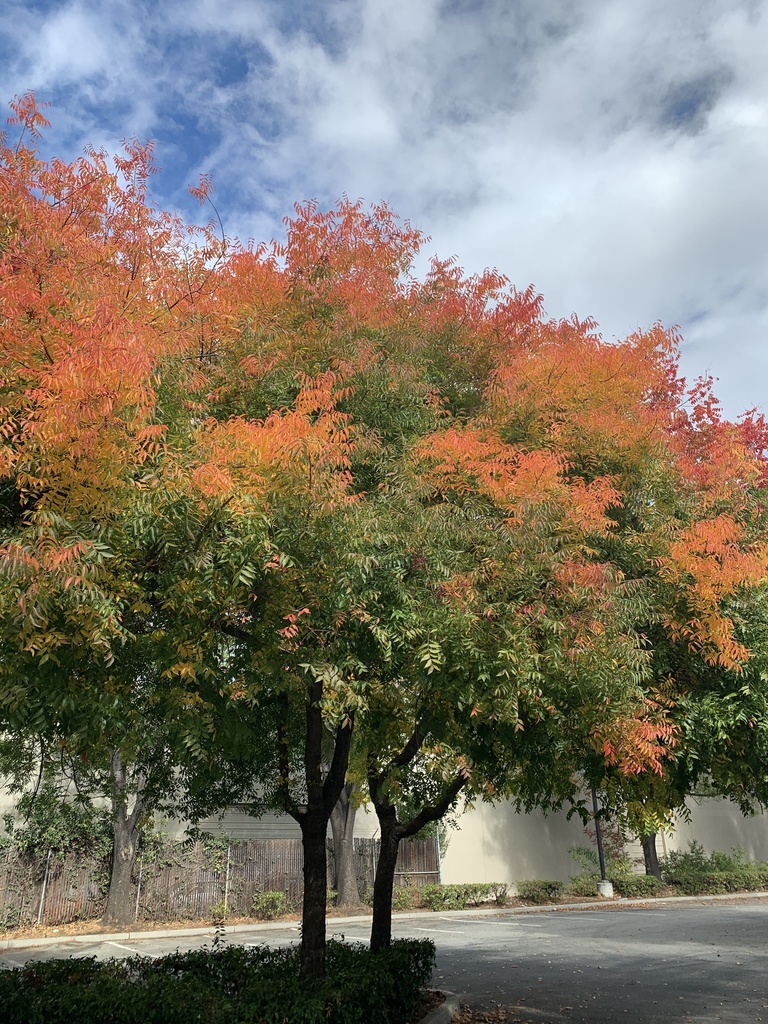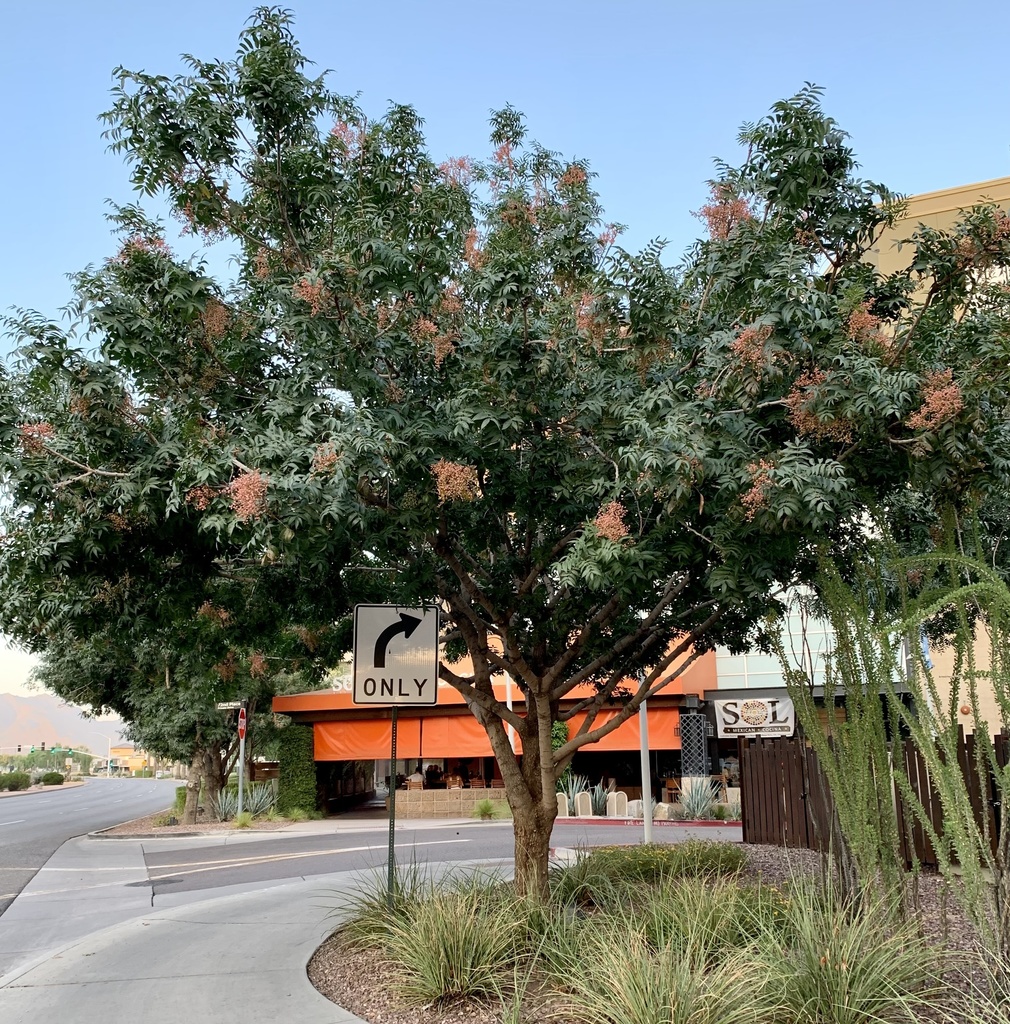Join the November EcoQuest: Peek at Pistache
For this EcoQuest, find and map as many pistache (Pistacia spp.) trees as possible.
Pistache trees have been recorded in metro Phoenix since 1963. Specifically, Chinese pistache (Pistacia chinensis) trees are being increasingly used for street trees in the area. Observations from this EcoQuest can help us see where these trees are growing, if they have invasive potential and learn about how wildlife may be utilizing them. We can also learn more about which pistache species can be found in metro Phoenix.

Pistache, like, pistachio? Yep! The genus Pistacia consists of 10-20 species of trees and shrubs in the cashew family, Anacardiaceae. The species Pistacia vera is grown commercially for pistachios. Other species can produce edible nuts, have medicinal properties or can be used as ornamentals. The most common species in metro Phoenix is Chinese pistache (Pistacia chinensis), which is an ornamental tree and unfortunately, not edible. There are six other known species recorded in the area. How did they end up in metro Phoenix? The origin of pistache in the area isn’t clear, but the first voucher dates back to 1963 and is of P. chinensis. It was documented as cultivated on the Arizona State University campus. The popularity of Chinese pistache as a great street tree is increasing, and it can now be found all over the valley.
Chinese pistache are tolerant of drought and alkaline soil, and are hardy down to negative 20 degrees Fahrenheit. The hard wood of these trees is resistant to rot and able to withstand windy conditions. They are relatively disease and pest free and can grow 2-3 feet a year once they’re established (3-5 years). Pruning is often not necessary and the canopy provides dense shade in the summer, and filtered light in the winter when they drop their leaves. If you’re looking for fall color, something that can be hard to come by in the Phoenix area, Chinese pistache puts on a colorful display around November and December, especially certain hybrids and cultivars.

These trees produce a considerable amount of fruit in clusters. These are not edible for humans, but birds and small mammals have been observed eating them. We don’t know much about wildlife and/or pollinators species that may be visiting these trees in metro Phoenix, so observations of these interactions are helpful. Birds can likely carry the seeds to new areas, but the invasive potential for Chinese pistache isn’t known. The fruit is said to be sterile unless male and female trees are nearby to one another. If you see this tree or other pistache species in natural areas, send a message with your observation to [email protected].
With increasing temperatures, frequency and severity of storms, and other climate change impacts, thinking about which plants can best handle these changing conditions is important. This is especially true in urban environments where harsh conditions can be amplified, such as urban heat island effect and nutrient depleted soils. Choosing the right plant for the right place can be tricky. Should we consider planting near-native (plants that are nearby in range and similar habitat to native plants) or introduced plants that can better tolerate these conditions, and provide ecosystem services over a longer period of time? This could be more beneficial than planting native trees that may not tolerate the conditions and pruning that urban settings demand. As an example, palo verde and mesquite trees are often pruned in ways that are not cohesive with their natural growth habits. This can lead to breaking and increased susceptibility to storm damage. Could we be mindful of the conditions that climate change is bringing while maintaining a balance of plants that support native wildlife, pollinators and people?

Chinese pistache photo by @thegardenhound
Fun Fact: Improper storage of pistachios in large quantities can spontaneously combust and start fires when stored with fibrous materials or oil-soaked fiber. The nuts have the tendency to self-heat, thanks to their high fat and low water content.
Observations from this EcoQuest can contribute population and occurrence data for pistache trees, specifically Chinese pistache, in urban settings. We can learn about species interactions for this tree, as well as possible invasive potential. We can also learn more about which species can be found in metro Phoenix and compare this to historic records.

Chinese pistache photo by @elena10
WHAT TO OBSERVE:
Common Name: Chinese Pistache
Scientific Name: (Pistacia chinensis)
OTHER SPECIES TO LOOK FOR
Pistacia atlantica, Pistacia integerrima, Pistacia lentiscus, Pistacia terebinthus, Pistacia texana, Pistacia vera
See the guide: https://www.inaturalist.org/guides/14576
SOURCES AND MORE INFORMATION:
EcoQuests are month-long challenges that are part of the larger Metro Phoenix EcoFlora project. Learn more by visiting our website.
Look for project happenings, EcoQuest announcements and more in the newsletter, project journal and on social media.
Sign up for the newsletter, The Metro Phoenix Field Guide.
Let’s be social on Instagram, Facebook, and Twitter.
Please do not observe indoor houseplants or pets.
For your own safety and the protection of plants and wildlife, do not trespass when making observations. Please follow all posted rules and guidelines in parks/preserves and do not enter private property.
Do not remove or move natural materials (plants, animals, rocks).
Respect wildlife (do not touch, feed, or disturb animals and keep a safe distance).
Observe COVID-19 Guidelines/Recommendations.
This is a great opportunity to observe and appreciate nature in our neighborhoods as we all navigate the complications of COVID-19. It is imperative that you follow COVID-19 guidelines/recommendations (wear a mask, practice physical distancing and wash your hands).
Do what’s best for you and your community.
For more COVID-19 information and guidelines, visit:
https://www.inaturalist.org/projects/city-nature-challenge-2020/journal/31768-cnc-covid-19
https://www.inaturalist.org/blog/31664-exploring-nature-when-you-re-stuck-at-home
Arizona Office of Tourism: Responsible Recreation in AZ
https://tourism.az.gov/responsible-recreation-across-arizona
